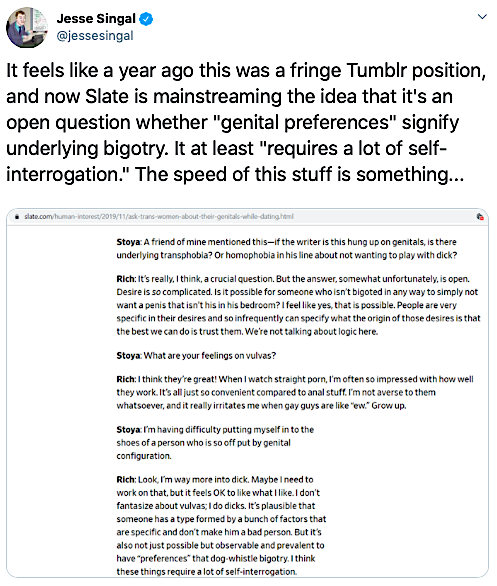News
Recently there have been many articles that demonstrate there are conflicting opinions around pediatric medical transition for gender dysphoria and ideological views about sex and gender. These conflicts are happening around the medical treatment of minors, free speech and censorship, sex-based rights issues with girls, and cultural disagreements in and outside of the LGBT population.
Medical Ethics & Parental Rights
A Canadian Court declines to consider criticism that giving tweens cross-sex hormones is too experimental to be given to minors (“Consent form for trans child's hormone therapy was insufficient, lawyer argues at appeal court”):
The father takes the position in court filings that Bowden erred by delivering a “rush to judgment,” and Dunton on Wednesday questioned whether the risk of suicide may have been “trumped up.”
The child and his supporters state in court filings that proper consent was obtained and that the law in B.C. is settled when it comes to affording youth the authority to decide their own medical treatments.
A father in Texas is fighting the transition of his son. A video the father took of the child, circulating online, seems to indicate the mother is actively encouraging the child’s transition. He is now under a gag order from the judge.
The Texas Governor is calling for an investigation (“A Texas man says his 7-year-old isn’t transgender. Now his custody fight has reached the governor’s office’).
A politician in Georgia is proposing outlawing medical treatment for minors:
State Rep. Ginny Ehrhart, R-Powder Springs, wants to make it a felony to change a child’s gender through surgery or drugs and plans to introduce her “Vulnerable Child Protection Act” in the Georgia General Assembly.
The Endocrine Society has urged its members not to make statements against pediatric transition. They are commenting on a case where it appears the mother may be leading the child to identify as trans based on a video the father released to the public.
Suppressing puberty is fully reversible.
The claim puberty suppression is fully reversible is very debatable.
In the UK, a mother is suing Britain’s youth gender clinic, claiming minors can’t give consent to irreversible medical treatment or possible side-effects from hormone blockers (“Mother sues Tavistock child gender clinic over treatments”). Other parents have joined the lawsuit (“Parents battle ‘state‑sponsored sterilisation’ of trans children”):
More than 30 families with transgender children are to lobby the government and the NHS against what they claim is “coerced medicalisation” — propelling vulnerable young people convinced they are the wrong gender towards treatments that risk leaving them infertile.
The group, provisionally called Our Duty, was formed after one mother went public to describe gender reassignment medication and surgery for those with autism or psychological problems as “state-sponsored sterilisation”.
The London Times has released a statement skeptical of the safety of current pediatric transition protocols (“The Times view on the Tavistock clinic and hormone-blocking drugs for the young: Informed Consent”).
The Times concerns mirrors that of some people in the health professions. “Gender dysphoria in children: puberty blockers study draws further criticism” criticizes the handling of medical treatment of gender dysphoric youth in the UK.
An Australian doctor and lawyer have written a paper questioning the safety of puberty blockers for transgender youth.
The court decisions, as in other areas, have followed medical evidence applications where there appears to have been no contrary opinion argued for. It would perhaps be helpful for a matter to come before the courts where a contrary opinion may be fully ventilated – for example, where the parents of a child had different views (supported by appropriate expert evidence) on the merits of Stage 1 and or Stage 2 treatment in a particular case. The current relative ease by which gender dysphoric children
Not everyone believes promoting gender ideology to children is healthy and safe. The article “How the trans debate entered the classroom” covers commentary from several professionals on the rise in the number of medicalized young people. The article states that people want to remain anonymous for fear of backlash if they offer up their honest concerns. Censorship is an ongoing problem around this issue:
‘This is one of the most complicated clinical areas of mental health and clinicians are often put under huge pressure to refer individuals, who believe this will solve their dysphoria, on for medical interventions,’ Dr Evans says. ‘Adolescence involves biological, psychological and sociological changes, and feelings of anxiety and confusion about their role required by society, and experimentation. I’m not saying no to gender transition, but services should resist the pull towards a quick solution that bypasses thoughtful exploration. How an adolescent feels now may not be how they feel in ten years’ time.’…
A senior psychoanalyst (like many I contacted, they asked to remain anonymous) told me ‘children are being seriously damaged’. ‘Gender dysphoria is being treated like an aesthetic,’ he said. ‘How can you consent for a 12-year-old? They’ll be infertile, on medical treatment for life, and if you cut out a piece of their gut to turn into a vagina, you’re not really making them into a woman. There should be a distinction between what someone wants and what is good for them.
Jenn Smith, a transgender person who is opposed to pediatric transition, has released a video discussing Smith’s viewpoints. Smith was a foster child, and there appears to be a link with adoption and foster situations and an increase in gender dysphoria. A gender clinician in BC (Dr. Wong) where Smith is from has stated 1/2 of his patients are “from the Ministry” in Canada. That information can be found here.
Jenn Smith states a caveat that these numbers are going by what Dr. Wong said himself and have not been verified by official statistics. If true, these are very high numbers of trans-identified foster kids:
500 of Wong’s patients are from the Ministry. The Ministry has 6500 kids in it’s care. So when you do the math there what you discover is that that 7.7% of all the children is the Ministry’s care are identifying as transgender and under the care of one doctor, just one doctor. There are other doctors out thoere. Like any family physician can basically perscribe hormones or whatever to kids and stuff. So it is not unreasonable for us to conclude the numers of foster children idenifying as transgender, might be as high as 1 in 10.
Another trans person who is against pediatric medical transition, FtM in this case, has posted an article about the harshness of medical transition on the body (What the medical professionals won't tell you about Transitioning genders, but I will).
Open Debate, Free Speech, & Censorship Issues
Several law professors in Australia signed a letter pledging to support transgender students after a Dean made comparisons of the increase of trans-identified youth to eating disorders.
Almost 40 law academics at the University of Queensland have signed an open letter pledging to support transgender students after the university’s law school dean presented a paper that compared transgender children to teens with eating disorders.
The dean’s response:
‘None of my colleagues have raised any concerns with me, and none have asked for a copy of the 14,000-word paper that I delivered last week. Had they done so, they would have found that it deals with issues that are being widely discussed in the medical and scientific literature.’
‘‘My background is in child protection. To suggest that we don’t tackle difficult issues because it might be challenging is to avoid the responsibilities of intellectual leadership.’
It is a fact that even some experts in gender dysphoria are raising concerns that there may be cases that are influenced by body dysmorphia and social contagion. GHQ covers the reasons for these concerns here.
Below are two articles about the threats to people’s careers coming from trans activism. This topic is extensively covered in this section: Problems with a politicized climate of harassment & censorship. These problems include censorship, threats to one’s career, and threats to people's physical safety. or the safety of their family:
“The purge of trans-sceptical academics”
“Meet the academics hunted down and hounded out of jobs for having the 'wrong' thoughts”
“The trans-activists' witch hunt against academics threatens the whole of society”:
A chaperone accompanies you to your office. Inside, a panic alarm is kept within reach. Once, your office door was covered in urine. You’ve faced multiple death and rape threats. Abuse and harassment, delivered online and in person, have become routine features of your working life.
Sex-Based Rights and Trans Rights
MtF trans individuals have been dominating women and girls in sporting events. Recent research shows that males retain a biological advantage, even post medical transition. The article “‘Justice’ for trans athletes is unfair to girls like my daughter” article discusses the advantages MtF teens have over biological girls in high school:
Alanna has devoted countless days, nights and weekends to training. She pushes herself to shave mere fractions of a second from her race times, yet she positions herself at the starting line knowing that, even with all that training and with her best effort, the odds are against her, the numbers are against her and that fairness doesn’t really exist.
A school is reconsidering the transgender bathroom policy and has received backlash from trans activist:
PICKENS COUNTY, Ga. -- A Georgia school district says it's reversing its decision that would have allowed transgender students to use the bathroom that fits their gender identity.
The Pickens County school district cited death threats, student harassment and vandalism of school property in their decision.
The Economist has an article addressing the conflicts around trans policies in British schools where girls who are uncomfortable with dysphoric males in female changing areas are being expected to leave the area.
Cultural Conflicts within the LGBT Population
Some LGB people have split off from Europe’s largest LGBT organization, Stonewall UK, in Britain. Encouraging the medicalization of gender non-conforming children and the eradication of girls’ sex-based rights are cited as some reasons why. The new organization is called LGBAlliance.
Two articles about this split are below:
“Gay groups clash over ‘homophobic policies’”
“Lesbian barrister: my bosses bowed to transgender ‘hate mob’”:
Bailey was subjected to a torrent of abuse and death threats after she posted on social media: “Gender extremism is about to meet its match.”
Allison Bailey is a lesbian who supports the new LGBAlliance in the UK. She and others have received criticism and even harassment, mostly from the far left, because some believe they should not form their own LGB organization or be criticizing current trans activist policies. She responds in a Twitter thread saved here:
Stonewall UK is a political lobbying group. It‘s not democratically elected. It has no mandate to declare itself the voice of *all* LGBT ppl, yet it behaves as if it does — & is treated by government, charitable & private sector orgs as if it speaks for us all. It does not. 1/
Stonewall UK has spun LGBT rights so completely that *any* challenge or question to its agenda is deemed hate speech, rather than being a healthy & essential part of a functioning democracy. It made it respectable for youth to no platform, scream at & threaten feminists. 2/…
Brad Polumbo, a gay man, has written two articles supporting the concept of a separate LGB movement:
“Gay rights depend on our rejecting transgender radicalism and standing up for James Younger”
“It’s Time for ‘LGB’ and ‘T’ to Go Their Separate Ways”
Other gay men have started a Facebook group called Gay Men Address Gender Identity.
An article called “The Great Erasure” has been posted on Medium and is in line with the dissatisfaction some LGB people have with current LGBT organizations. The article is part opinion but is factually useful in tracking where funding is going for current LGBT organizations.
*GHQ remains a trans-inclusive organization as trans people are not all supportive of pediatric medical transition or denying the concept of biological, chromosomal, sex. Some LGB people are supportive of these things. But all identity groups should be free to organize individually to focus on specific issues.
Not everyone believes the current cultural obsession with pronouns, and identity in general, is healthy. GHQ holds that position as well. This culture is resulting in protests like the recent “S***-In” at San Francisco University protesting the need for more non-binary bathrooms. And this presentation of postmodern queer theory to children by the BBC that lacks scientific discourse and promotes views that are controversial within the LGBT population.
An article written by a GHQ advisory board member called “Amid ‘Erosion in Acceptance’ L Word Loses the Plot & GLAAD Targets Youth” covers some of these cultural issues and the growing numbers of lesbians critical of current “LGBT activism:”
Amid “erosion of acceptance,” the organizations that were supposed to protect us, have campaigned to silence us, using threats and slurs to invoke fear and shame. The L Word has lost all sense of the plot… Yet although mainstream media and “LGBTQ” organizations have pulled out every trick in their “playbook,” the one thing they’ve deeply underestimated is the power of dyke rage.
Andrew Sullivan, a gay man, has written an article about transitioning children and the effects of trans activism on gay rights called “When the Ideologues Come for the Kids”:
Last week, I defended drag queens reading stories to kids in libraries. I don’t take back my words. Getting children interested in reading with costumed clowns strikes me as harmless. But when I was directed to the website of Drag Queen Story Hours, I found the following:
“[DQSH] captures the imagination and play of the gender fluidity of childhood and gives kids glamorous, positive, and unabashedly queer role models. In spaces like this, kids are able to see people who defy rigid gender restrictions and imagine a world where people can present as they wish, where dress up is real.”
However well-meant, this is indoctrination into an ideology, not campy encouragement for reading and fun.
Sullivan included a link to our evidence supported section on the large increases of trans-identified youth ("sky-rocketed”):
In the last few years in Western societies, as these notions have spread, the number of children identifying as trans has skyrocketed. In Sweden, the number of kids diagnosed with gender dysphoria, a phenomenon stable and rare for decades, has, from 2013 to 2016, increased almost tenfold. In New Zealand, the rate of girls identifying as boys has quadrupled in the same period of time; in Britain, where one NHS clinic is dedicated to trans kids, there were around a hundred girls being treated in 2011; by 2017, there were 1,400.
It is not only LGB people critical of aspects of current trans activism. “I am a trans woman – but I think this woke world has gone too far” is written by an MtF trans person:
Trans people have lost the plot. Every day, an increasing amount of absurdity floods in as they do more harm than good. They scream for acceptance without realizing that the ones damaging their image aren't bigots, but themselves.
From anger directed at celebrities for the rational belief that parents shouldn't decide whether their three-year-old is trans, to a culture of outrage that freaks out at the most minor of offenses, transgender activists have become detrimental to my, and others', very existence.
Not helping matters is the fact that these people are laying bombs within our language in the hope they trigger, so they themselves can become triggered. Saying 'transgendered' instead of 'transgender' can see you labeled as transphobic, as can saying 'transwomen' instead of 'trans (notice the space) women.' This is a linguistic minefield with the sole intent of catching people off guard. And those who are caught in its blast are branded as bigots.
Two articles have been released criticizing the recent pronoun announcements and the LGBT Townhall with Democratic candidates. The Townhall was complete with pronoun announcements, a trans-identified small child presented in front of the camera, and an accusation that misgendering is “violence:”
”Democratic Candidates Displaying Gender Pronouns On Their Twitter Accounts Are Making A Big Mistake”
“CNN LGBTQ town hall reveals the madness of identity politics”
Dr. Karen Blair, a psychologist and SOGI advisor in Canada, has released a video calling sexual orientation that is not inclusive of trans identities problematic and in need of social change. GHQ responded to this type of discourse by sending Dr. Blair a letter in June adhering to the reality that there are biologically driven sexual orientations and that people have the right to them without being painted as problematic and in need of social justice activism by the psychology profession.
From the video:
I, and this study’s researchers involved in this study, believe that this is an issue that needs to be discussed openly and honestly, not ignored. Because only then can we fix it.
This type of commentary is causing major conflicts within the LGBT population and is one of the reasons for the LGB split from Stonewall UK. We cover that issue here.
There are conflicts happening around race and identity at WPATH (who sets the standards for trans healthcare), where minorities took over the stage to call for more representation.
References:
Armus, T. (2019, October 24). A Texas man says his 7-year-old isn’t transgender. Now his custody fight has reached the governor’s office. Washington Post. https://www.washingtonpost.com/nation/2019/10/24/james-younger-luna-transgender-greg-abbott/
BBC. (2019). RSE KS2: Identity - Understanding sexual and gender identities. Retrieved from https://www.bbc.co.uk/teach/class-clips-video/rse-ks2-identity-understanding-sexual-and-gender-identities/zfqrhbk
Brunskell-Evans, H. The purge of trans-sceptical academics. Spiked. Retrieved from https://www.spiked-online.com/2019/06/26/the-purge-of-trans-sceptical-academics/?fbclid=IwAR3ixz9mTy2UeKeDmOYZ4RkKD2niM6c95lz3KHIyCzsaGl_l5ko5XtL8CUM#.XbDDKGf9i18.facebook
Cohen, B. (2019, July 22). Democratic Candidates Displaying Gender Pronouns On Their Twitter Accounts Are Making A Big Mistake. https://thebanter.substack.com/p/democratic-candidates-displaying
Cohan, D., Barnes, H. (2019, September 20) “Gender dysphoria in children: puberty blockers study draws further criticism”. The BMJ (366). doi.org/10.1136/bmj.l5647
Driscoll, M. (2019, September 19). Meet the academics hunted down and hounded out of jobs for having the 'wrong' thoughts. The Telegraph. Retrieved from https://www.telegraph.co.uk/women/life/meet-academics-hunted-hounded-jobs-having-wrong-thoughts/
Donym, S. (2019, October 16). The Great Erasure. Retrieved from https://medium.com/@sue.donym1984/the-great-erasure-203a124fa02c
Emmons, L. (2019, October 14). CNN LGBTQ town hall reveals the madness of identity politics. The Post Millenial. Retrieved from https://www.thepostmillennial.com/cnn-lgbtq-town-hall-reveals-the-madness-of-identity-politics/
Endocrine Society.. (2019, October). Endocrine Society Urges Policy Makers to Follow Science on Transgender Health. Endocrine News. Retrieved from https://endocrinenews.endocrine.org/endocrine-society-urges-policymakers-to-follow-science-on-transgender-health/
Gibbons, K. (2019, October 26). “Gay groups clash over ‘homophobic policies’.” The Times.[London]. Retrieved from https://www.thetimes.co.uk/article/gay-groups-clash-over-homophobic-policies-t95958fmn?shareToken=c602067cb10e7c01e71fba89ac8bbdab
Hellen, N. (2019, October 27). Lesbian barrister: my bosses bowed to transgender ‘hate mob.’ The Times [London]. https://www.thetimes.co.uk/article/lesbian-barrister-my-bosses-bowed-to-transgender-hate-mob-shm6x09v8?fbclid=IwAR1bP7iQHAj2hK7-xaV3v2AaTvOHy7wkkrT5ZcIxxWAqq7lc47ca7Lj6fKM
Hurst, G. (2019, October 12). Mother sues Tavistock child gender clinic over treatments. The Times.[London]. Retrieved from https://www.thetimes.co.uk/article/mother-sues-tavistock-child-gender-clinic-over-treatments-r9df8m987
Intersectional Bullies Crash Trans Health Town Hall. Retrieved from https://www.youtube.com/watch?time_continue=69&v=zHlnQMY9KM0
Jenn Smith Calls for National Inquiry into mass gender transitioning of Vulnerable kids. Retrieved from https://www.youtube.com/watch?app=desktop&feature=youtu.be&v=VxTtkI51xH4
Manins, R. (2019, October 30). Cobb legislator proposes new law to criminalize physical gender change of children. Marrietta Daily Journal. Retrieved from https://www.mdjonline.com/news/cobb-legislator-proposes-new-law-to-criminalize-physical-gender-change/article_01d7e572-fb4c-11e9-b280-5bf7ecee1ac6.html
O’Conner, M., Madden, B. (2019). In the Footsteps of Teiresias: Treatment for Gender Dysphoria in Children and the Role of the Courts. Journal of Law and Medicine 27 (1). Retrieved from http://sites.thomsonreuters.com.au/journals/2019/10/22/journal-of-law-and-medicine-update-vol-27-pt-1/
Narwitz, S. (2019, October 19). I am a trans woman – but I think this woke world has gone too far. RT. Retrieved from https://www.rt.com/op-ed/471025-trans-woman-woke-too-far/
Polumbo, B. Gay rights depend on our rejecting transgender radicalism and standing up for James Younger. Washington Examiner. Retrieved from https://www.washingtonexaminer.com/opinion/gay-rights-depend-on-our-rejecting-trans-radicalism-and-standing-up-for-james-younger
Polumbo, B. It’s Time for ‘LGB’ and ‘T’ to Go Their Separate Ways. Quillette. Retrieved from https://quillette.com/2019/10/26/its-time-for-lgb-and-t-to-go-their-separate-ways/
Radachowsky, C. (2019, October 13). ’Justice’ for trans athletes is unfair to girls like my daughter. New York Post. Retrieved from https://nypost.com/2019/10/13/justice-for-trans-athletes-is-unfair-to-girls-like-my-daughter/
Roberson J.D. (2019, September 10). Amid ‘Erosion in Acceptance’ L Word Loses the Plot & GLAAD Targets Youth. The Velvet Chronicle. Retrieved https://thevelvetchronicle.com/amid-erosion-in-acceptance-glaad-targets-youth-l-word-loses-the-plot/
Quan, D. (2019, September 4). Consent form for trans child's hormone therapy was insufficient, lawyer argues at appeal court. National Post. Retrieved from https://nationalpost.com/news/consent-form-for-trans-childs-hormone-therapy-was-insufficient-lawyer-argues-at-appeal-court
Smee, B. (2019, September 18). University of Queensland academics sign open letter after law dean's trans comments. The Guardian. Retrieved from https://www.theguardian.com/australia-news/2019/sep/18/university-of-queensland-academics-sign-open-letter-countering-law-deans-trans-comments?fbclid=IwAR3Rh2y75YlstvJ86xp0OjHzPajCgMghWaAIOBJjtiwUYrTlvk9iJg6EZZA
Stonewall UK . Retrieved from https://threadreaderapp.com/thread/1190704005648965632.html
Sullivan, A. (2019, September 20). When the Ideologues Come for the Kids. New York Magazine. Retrieved from http://nymag.com/intelligencer/2019/09/andrew-sullivan-when-the-ideologues-come-for-the-kids.html?utm_medium=s1&utm_campaign=nym&utm_source=tw
Transgender rules for English schools face a backlash from women. (2019, )ctober 3). The Economist. Retrieved from https://amp-economist-com.cdn.ampproject.org/c/s/amp.economist.com/britain/2019/10/03/transgender-rules-for-english-schools-face-a-backlash-from-women
Terry, M. (2019, September 4). How the trans debate entered the classroom. Spectator Life. Retrieved from https://life.spectator.co.uk/articles/the-gender-agenda/
The Exclusion of Trans People from the World of Dating. Retrieved from https://www.patreon.com/posts/new-video-29553352
The Times view on the Tavistock clinic and hormone-blocking drugs for the young: Informed Consent. The Times [London]. Retrieved from https://www.thetimes.co.uk/article/def68adc-ec4f-11e9-b931-c019e957f02a
Walsh, J. (2019, October 26). Parents battle ‘state‑sponsored sterilisation’ of trans children. The Times [London]. Retrieved from https://www.thetimes.co.uk/article/parents-battle-state-sponsored-sterilisation-of-trans-children-mb55fxt60
WGXA. (2019, October 16). Georgia school district reverses decision on transgender bathroom policy. Retrieved from https://wgxa.tv/news/local/georgia-school-district-reverses-decision-on-transgender-bathroom-policy.
What the medical professionals won't tell you about Transitioning genders, but I will. (2019, October 15). Retrieved from https://thetransgendertruth.wixsite.com/mysite/post/what-the-physiologists-surgeons-and-physicians-don-t-tell-you-about-transitioning-genders
Williams, J. (2019, October 8). “The trans-activists' witch hunt against academics threatens the whole of society.” The Telegraph. Retrieved from https://www.telegraph.co.uk/news/2019/10/08/trans-activist-witch-hunt-against-academics-threatens-whole/?WT.mc_id=tmg_share_tw
Yavitch, E. (2019, October 24). Students hold ‘Shit In’ to demand more gender-neutral bathrooms. The College Fix. Retrieved from https://www.thecollegefix.com/students-hold-shit-in-to-demand-more-gender-neutral-bathrooms/























































